Did you know the Philippines is home to over 175 ethnolinguistic groups, each with unique traditions? Among these, pre-colonial dance stands out as a vibrant art form deeply rooted in rituals and celebrations. Long before foreign influences shaped the archipelago, indigenous communities used movement and music to tell stories, honor deities, and mark significant events.
These dances were more than just performances; they were a way to connect with nature, ancestors, and the divine. From the graceful Banga dance, where women balanced pots on their heads, to the energetic Singkil, which narrated epic tales, each style reflected the values and beliefs of its people. This article explores how these ancient practices evolved, blending indigenous traditions with external influences to create a rich cultural tapestry.
Key Takeaways
- Pre-colonial Philippine dance was a vital part of rituals and celebrations.
- Movement and music were used to convey symbolic messages.
- Each dance style reflected the values and beliefs of its community.
- These practices evolved by blending indigenous and foreign influences.
- Dances like Banga and Singkil showcase the creativity of Filipino culture.
Historical Foundations of Pre-Colonial Philippine Dance
Long before foreign influences, indigenous Filipinos used rhythmic movement to connect with their environment and ancestors. These practices were not just physical expressions but deeply rooted in spiritual and cultural traditions. From honoring deities to celebrating harvests, every performance carried profound meaning.
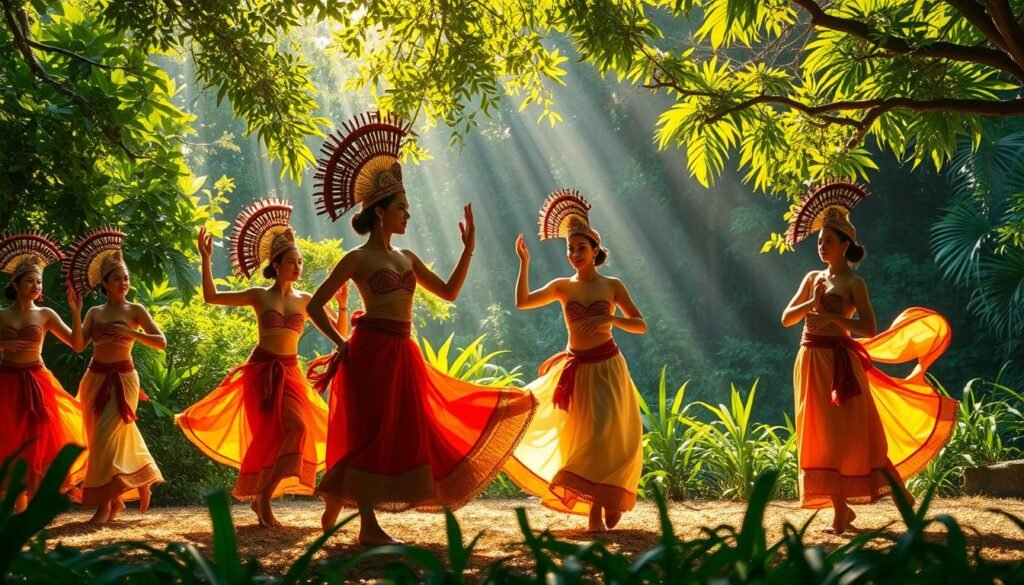
Origins and Early Influences
The earliest forms of movement in the Philippines were tied to rituals. Indigenous communities believed that these practices could communicate with the divine. For example, the Banga style, where women balanced pots on their heads, symbolized strength and grace. Similarly, the Singkil performance narrated epic tales through intricate steps and rhythm.
These traditions were influenced by the natural world. The swaying of trees, the flow of rivers, and the patterns of animals inspired the style and form of these practices.
“Every step was a prayer, every gesture a story,”
reflecting the deep connection between people and their environment.
Evolution Through Generations
Over time, these practices evolved. New techniques emerged, blending indigenous traditions with external influences. For instance, the introduction of music from neighboring cultures added layers of complexity to performances. The folk elements remained central, ensuring that the culture and identity of the people were preserved.
Today, these ancient practices continue to inspire modern interpretations. They serve as a reminder of the Philippines’ rich heritage and the enduring power of movement as an art form. To learn more about the cultural significance of these traditions, explore this guide on ancient Filipino scripts.
The Significance of Dance in Pre-Colonial Rituals and Celebrations
In pre-colonial Philippines, movement was a language of its own, deeply tied to rituals and spirituality. Indigenous communities used rhythmic practices to communicate with the divine, celebrate harvests, and honor their ancestors. These performances were not just physical acts but profound expressions of cultural identity.
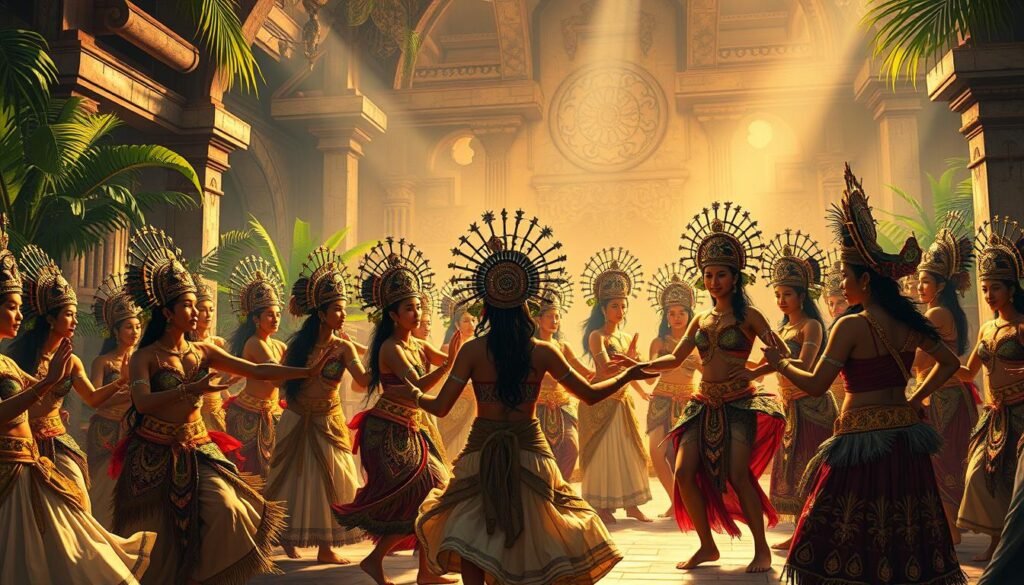
Ritualistic Functions and Ceremonial Roles
Movement played a central role in pre-colonial ceremonies. For example, the Banga style, where women balanced pots on their heads, symbolized strength and grace. The Singkil performance narrated epic tales through intricate steps and rhythm. These practices were essential in rituals for good harvests, health, and peace.
Dancers often held ceremonial roles, acting as intermediaries between the physical and spiritual worlds. Their performances were believed to bring blessings and ward off evil spirits.
Cultural Beliefs and Spiritual Practices
Cultural beliefs were deeply intertwined with the practice of movement. The swaying of trees and the flow of rivers inspired the style and form of these rituals. Every gesture carried symbolic meaning, reflecting the community’s connection to nature and the divine.
Music and rhythm enhanced the ceremonial atmosphere. Instruments like the kulintang and gangsa added layers of complexity, making the experience emotionally impactful for participants and onlookers alike.
| Ritual | Purpose | Key Elements |
|---|---|---|
| Banga | Symbolize strength and grace | Balancing pots, rhythmic steps |
| Singkil | Narrate epic tales | Intricate movements, bamboo props |
| Tachok | Celebrate births and weddings | Gong accompaniment, joyful steps |
These ancient practices continue to inspire modern interpretations, preserving the Philippines’ rich cultural heritage. Through movement, communities found a way to express their beliefs, emotions, and unity.
The Role of Music and Movement in Pre-Colonial Dance
Music and movement were inseparable in pre-colonial Philippine traditions. Indigenous communities used rhythmic patterns and expressive gestures to convey stories, honor deities, and celebrate life. These performances were not just artistic expressions but also spiritual practices deeply rooted in culture.
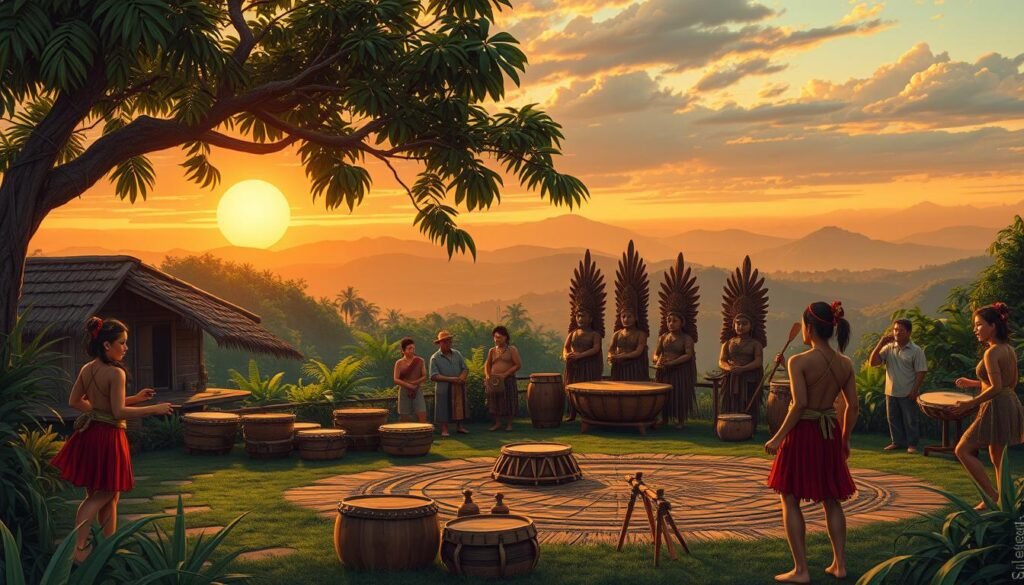
Integration of Musical Accompaniment
Musical instruments played a vital role in enhancing the ritualistic impact of these performances. Native instruments like the kulintang and gangsa created rhythmic patterns that guided the dancers’ movements. The interplay between sound and motion brought depth to the storytelling.
For example, the Singkil performance used bamboo poles to create a rhythmic beat. Dancers moved in sync with the music, weaving intricate steps that narrated epic tales. This integration of music and movement was a hallmark of pre-colonial traditions.
Expressive Body Movements and Rhythms
Body movements in these performances were both structured and spontaneous. Every gesture, from the sway of the arms to the placement of the feet, carried symbolic meaning. The rhythm of the music dictated the pace and style of the movements.
In the Banga style, women balanced pots on their heads while moving gracefully to the beat. This combination of strength and elegance showcased the dancers’ skill and the cultural values they represented.
| Performance | Musical Instrument | Key Movement |
|---|---|---|
| Singkil | Bamboo poles | Intricate footwork |
| Banga | Drums | Balancing pots |
| Tachok | Gongs | Joyful steps |
These traditions highlight the balance between structured movement and spontaneous expression. Through music and motion, pre-colonial communities preserved their cultural identity and shared their stories with the world.
Expressions and Symbolism in Cultural Celebrations
In the heart of Filipino traditions, movement and symbolism intertwine to tell stories of the past. These practices are not just physical acts but profound expressions of cultural identity. Through gestures, costumes, and rhythmic patterns, indigenous communities convey values, beliefs, and emotions.
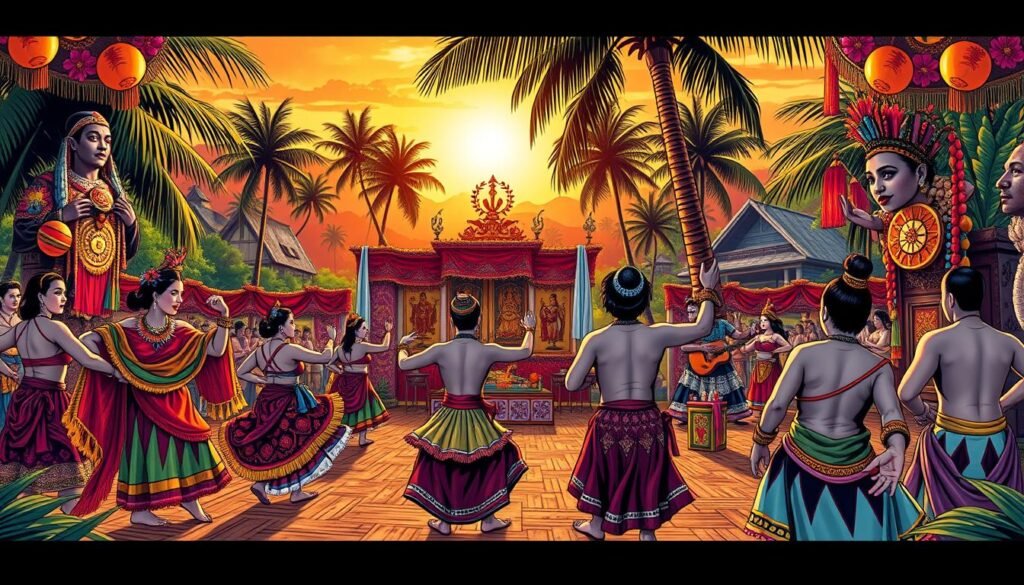
Storytelling Through Movement
Movement serves as a powerful narrative device in traditional celebrations. Every step, sway, and gesture carries symbolic meaning, often rooted in ancestral stories. For example, the Singkil performance uses intricate footwork to narrate epic tales, blending music and motion seamlessly.
These practices are not just about entertainment; they are a way to preserve history. Through movement, communities pass down stories of heroism, love, and resilience to younger generations.
Symbolic Gestures and Traditional Costuming
Symbolism extends beyond movement to include gestures and attire. Traditional costumes often feature colors and patterns that represent cultural heritage. For instance, the use of beads in certain performances symbolizes promises and commitments.
Facial expressions also play a crucial role. A dancer’s smile or solemn gaze can convey emotions, adding depth to the storytelling. These elements work together to create a rich, immersive experience.
- Movement narrates traditional stories, preserving cultural history.
- Specific gestures and expressions carry deep symbolic meanings.
- Traditional costumes enhance storytelling with their intricate designs.
- Symbolic elements like beads represent ancestry and cultural values.
- Folk traditions and symbolic practices are deeply interconnected.
- These expressions add deeper meaning to cultural celebrations.
- They strengthen community identity and ensure cultural continuity.
These traditions highlight the importance of movement and symbolism in Filipino culture. They serve as a bridge between the past and present, ensuring that ancestral stories and values remain alive. To explore more about the cultural significance of these practices, visit this guide on the history and meanings of dance.
Traditional Dance Styles and Techniques
The Philippines boasts a rich tapestry of traditional movement practices, each reflecting the unique identity of its region. These styles were not just forms of entertainment but also vital expressions of cultural heritage. From the intricate steps of Tinikling to the graceful Banga, every movement carried deep meaning.
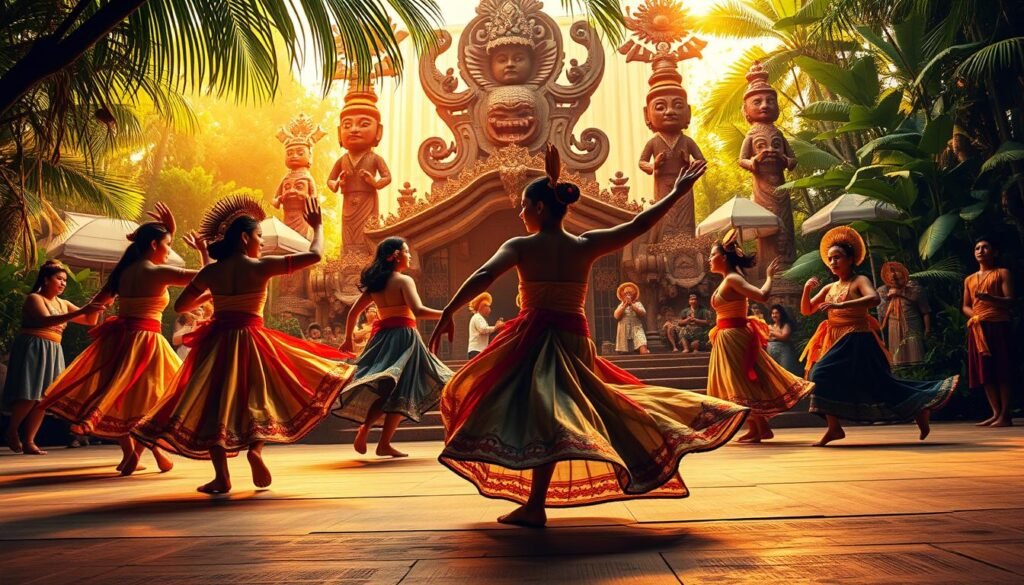
Folk Dance Variations and Social Dancing
Folk movements in the Philippines vary widely, each tied to specific communities and traditions. For example, Tinikling involves four participants, with two holding bamboo poles and two stepping rhythmically between them. This group activity symbolizes unity and coordination.
Social dancing also played a significant role in pre-colonial society. These gatherings were opportunities for communities to bond and celebrate. The music and movement created a lively atmosphere, fostering a sense of togetherness.
Choreography and Ritual Movements
Choreography in traditional practices was carefully planned to meet ritual or social demands. Movements were often symbolic, representing stories or spiritual beliefs. For instance, the Singkil performance narrates epic tales through intricate steps and spatial arrangements.
Body posture and coordinated steps were essential elements. Dancers maintained precise form to convey the intended message. Traditional costumes and props, such as bamboo poles or pots, enhanced the visual impact of the performance.
Regional differences influenced the structure of these movements. Each community adapted its style to reflect local customs and beliefs. To explore more about the diversity of traditional practices, visit this guide on dance styles.
Preservation and Modern Revival of Pre-Colonial Dance
Efforts to preserve and revive pre-colonial Philippine traditions have gained momentum in recent years. These initiatives aim to keep ancient practices alive while adapting them to modern contexts. From educational programs to cultural festivals, communities are finding innovative ways to celebrate their heritage.
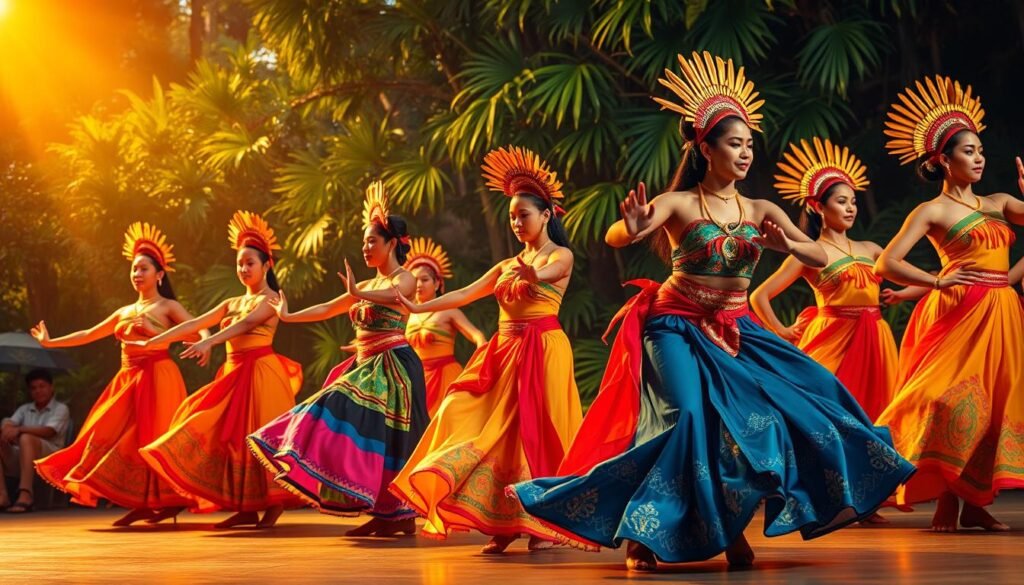
Educational Initiatives and Community Engagement
Schools and cultural organizations play a key role in preserving these traditions. Workshops and classes teach younger generations about the movement and rhythm of pre-colonial practices. These programs often include hands-on lessons in traditional music and performance techniques.
Local governments also support these efforts. They fund festivals and events that showcase indigenous art forms. Community engagement ensures that these traditions remain a living part of Filipino culture.
Contemporary Interpretations and Cultural Events
Modern dancers and choreographers are reinterpreting pre-colonial movements. They blend traditional steps with contemporary style, creating performances that resonate with today’s audiences. These works often explore themes of identity, history, and emotion.
Cultural events like the Kaamulan Festival and Pahiyas Festival celebrate indigenous traditions. These gatherings bring communities together, fostering pride in their shared heritage. Modern media, including films and social platforms, also help spread awareness of these practices.
- Educational programs teach traditional movement and music.
- Local governments fund festivals to showcase indigenous art.
- Contemporary dancers blend old and new styles.
- Cultural events like Kaamulan celebrate heritage.
- Modern media helps spread awareness of pre-colonial traditions.
These efforts ensure that pre-colonial traditions remain vibrant and relevant. To learn more about the cultural significance of these practices, explore this guide on the preservation of Filipino folk dances.
Conclusion
Pre-colonial Philippine movement traditions hold a unique place in the nation’s cultural heritage. Rooted in rituals and celebrations, these practices were more than just performances—they were a way to connect with nature, ancestors, and the divine. From the graceful Banga to the intricate Singkil, each style carried profound meaning, reflecting the values and beliefs of its community.
Music and movement were inseparable, with rhythmic patterns guiding every gesture. These traditions evolved over time, blending indigenous practices with external influences. Today, efforts to revive and preserve these art forms are bridging the past and present, ensuring their relevance for future generations.
Preserving these traditions is vital. They serve as a reminder of the Philippines’ rich history and the enduring power of culture. By engaging with local practices, we honor the creativity and resilience of our ancestors. To explore more about the significance of these traditions, visit this guide on preserving cultural expressions.
FAQ
What were the origins of pre-colonial Philippine dance?
Pre-colonial Philippine dance traces its roots to indigenous rituals, cultural traditions, and early influences from neighboring regions. These movements were deeply tied to spiritual practices and community celebrations.
How did dance play a role in pre-colonial rituals?
Dance was integral to rituals, serving ceremonial roles and reflecting cultural beliefs. It was used to honor deities, mark life events, and connect communities spiritually.
What was the significance of music in pre-colonial dance?
Music was essential, providing rhythm and enhancing the emotional impact of movements. Instruments like gongs and drums accompanied dances, creating a harmonious blend of sound and motion.
How did storytelling feature in pre-colonial dance?
Storytelling was woven into movements, with gestures and choreography narrating myths, legends, and historical events. This made dance a powerful medium for preserving oral traditions.
What are some traditional pre-colonial dance styles?
Folk dance variations, such as the Tinikling and Singkil, were popular. These styles often featured intricate footwork, rhythmic patterns, and symbolic gestures.
How is pre-colonial dance preserved today?
Preservation efforts include educational programs, cultural festivals, and community workshops. Contemporary artists also reinterpret traditional movements to keep them relevant.
What role did costumes play in pre-colonial dance?
Costumes were symbolic, often representing cultural identity, social status, or spiritual themes. They added visual depth to performances and enhanced storytelling.
How has pre-colonial dance evolved over time?
While rooted in tradition, pre-colonial dance has adapted to modern contexts. Today, it blends historical elements with contemporary influences, ensuring its continued relevance.
Source Links
- From Tradition to Identity: Exploring the Cultural Heritage of the Philippines
- Dance in the Philippines
- Discover the Rich Pre-Colonial History of the Philippines – Festive Pinoy
- Journal for the Anthropological Study of Human Movement | Vol. 22 No. 1
- Cultural achievements of pre-colonial Philippines
- Exploring the Diversity of Philippine Folk Dances – Pinas Culture
- Southeast Asian arts – Folk Traditions, Rituals, Crafts | Britannica
- Folk dance | Definition, Music, History, Types, & Facts | Britannica
- Traditional Dance: Meaning & Symbolism
- Dance – Movement, Expression, Art | Britannica
- Symbolism in The Wedding Dance by Amador Daguio | Storyboard That
- Dance – Styles, Movements, Techniques | Britannica
- The Fabulous Traditional and Folk Dances in the World –
- Styles of Dance | How to Choose a Dance Style | BLOCH US
- History of Philippines Folk Dance
- Dance notation – Systems, Symbols, Preservation | Britannica
- No title found
- An Invitation to Dance: Conclusions and Implications – Women Priests

